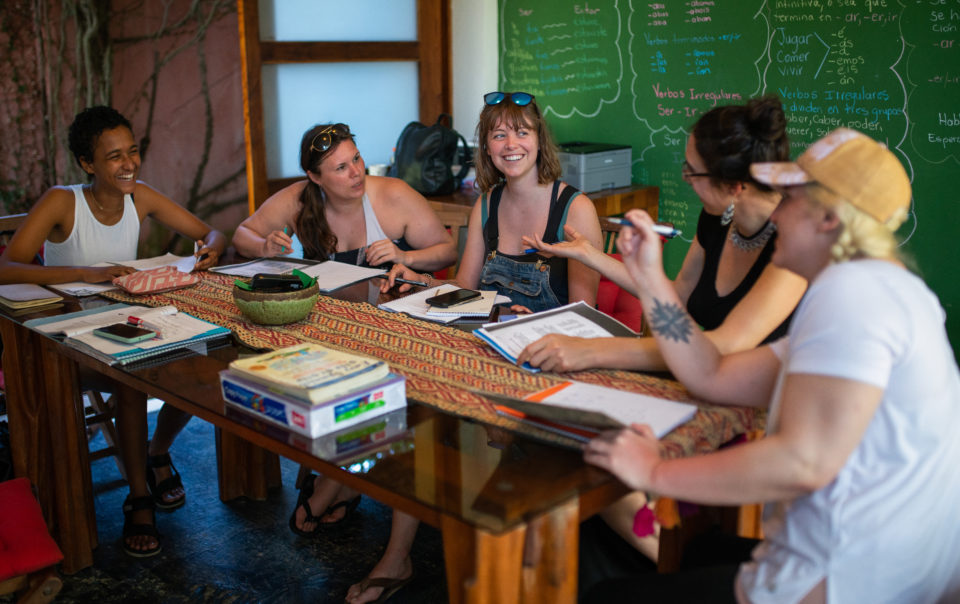
It always blows me away when I hear someone say that they don’t like fruit. Granted I grew up as the daughter of a health freak, but still I can’t think of a candy sweeter than fresh mango ripened to perfection. Since I’ve lived here in Costa Rica I’ve gotten even more hooked on tropical fruits, because they taste so much better here- due in part to the fact that they are allowed the chance to properly ripen. In fact, I don’t think I will ever be able to eat a pineapple any where else, as the sweet nectar of the locally grown pineapple is an delectable treat for any palette. The treats don’t end with the pineapples though, Costa Rica boasts an entire array of unique and sinfully delicious fruits unknown to most foreigners.
Many Fridays the School of the World Spanish class will take a trip to the local fruit market during their lab class, and in that time our Spanish teachers take pride in introducing the students to some local fruits. Here is a brief introduction to a few of the unique fruits we have here in Costa Rica:
Mamón Chino
Momon chino is about the size of a golfball and looks like a furry strawberry
or a mutated sea urchin. or a mutated sea urchin. Though its exterior may seem off-putting, when peeled the fruit has a cloudy white flesh which has a grape-like texture. (In English this fruit is known as Rambutan and is native to Indonesia). It is closely related to lychee. The best way to tackle eating this fruit is to bite off a piece of the skin and peel it from there. The edible part is the glimmering white oval ball on the inside which one can pop in their mouth to gently suck the flesh off the pit. This is where the name mamón comes from, translated loosely as “sucking”. The second half of the fruits name, chino is due to the fact that these fruits are hailed from Malaysia. The fruit itself is slightly sweet with a hint of sourness, particularly when not yet fully ripened. Some people like to freeze them for a nice cold snack on hot days.
Jacote
Jacote is a fruit which looks like a small deformed golfball and its colors range from green to yellow to red. The fruit can be eaten both when its skin is green and unripe as well as once it has matured and turned red or yellow. Ripe and unripe alike, the fruit maintains a tartness to its flavor. Initially upon biting into the fruit your tongue is bombarded by an intense wave of sourness which then subsides into a semi-sweet flavor with a chalky texture. The closer to the pit you get, the sweeter the fruit becomes. It is also possible to eat the skin of this fruit as well!
Cas
Cas is similar to Jacote as it to is a small greenish yellow round fruit,
however, its internal features are markedly different than Jacote. Inside this fruit lies a juicy center with dozens of small, white seeds that are edible if they are chewed with enough force. Though the fruit itself isn’t might seem a bit odd, it is actually a type of guava which is relatively easy to find in United States markets. Unlike guava, Cas has a sourness to its taste which can only be likened to that of sucking on a lemon. Rather than eat the fruit on its own, locals often make juice out of it. Cas flavored juices are a popular favorite at many Costa Rican restaurants.
Tamarindo
Tamarindos look like a cross between a brown lumpy banana and a boomerang. When ripe the skin becomes brittle and easily cracked, once cracked open there is 1-12 fully formed seeds that are hard, glossy brown and sqaurish in form with a brown pulp surrounding it. Tamarindo is often used as a spice or to make refrescos. The refrescos are similar in look and taste to that of apple juice. A popular candy recipe for Tamarindo involves warming up tamarindo paste or pulp, letting it cool into a putty like consistency, cutting it into small peices and rolling it in sugar.
Part of taking a Spanish immersion course in Costa Rica involves learning about the Latin culture and way of life as well as the language. Being introduced to these fun and new fruits is both a informative and delicious way of doing so!
costa ricaCosta Rica Spanish immersionlearn Spanish in Costa Ricaschool of the worldSpanish classesspanish school costa rica
Check out all the fun we’re having, right now, at the School of the World!
to reach our office directly +506.2643.2462
to reach a guest +506.2643.1064
U.S. number that connects to our office
+1-305-517-7689
schooloftheworld (skype)
Check out all the fun we’re having, right now, at the School of the World!
to reach our office directly
+506.2643.2462
to reach a guest +506.2643.1064
U.S. number that connects to our office +1-305-517-7689
schooloftheworld (skype)







